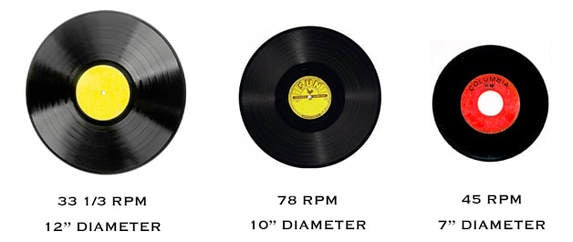Most people also know that records come in two different speeds – the majority records are played at 33 1/3 Revolutions Per Minute (RPM), while some, usually singles or special editions, are played at 45 RPM. Some older formats, though, run at 78 RPM. This was the earliest format that we’d recognise as a “record”. Your ancestor’s gramophone played 78 records as far back as 1901.

By today’s standards, 78s are a bit of an odd creature. They only had a few minutes to a side (some say that’s why modern pop songs are about are 3 - 5 minutes long) and they actually predate vinyl as a material – most were made of a shellac medium, although there were plenty of odd alternatives around. Grooves were a lot bigger on a 78 too. They were often played with something akin to a metal pin. The slang here is why we say “needle” when we’re talking about a diamond stylus that modern turntables use (modern, meaning since the 1960s…). Current generation records have a much finer groove, due to better pressing and cutting techniques. These are referred to as “microgroove” and has been the standard since about 1948.
Still, there’s plenty of 78s lying around. Mostly you’ll find them as antiques or in the odd treasure trove when crate digging through an op shop. You might get a bit macabre and pick them up from someone’s deceased estate sale. Over the last few years, the industry has seen some artists releasing limited editions on 78. Or in the case of Jack White, having a secret 78 track on an otherwise 33 RPM record. These are special releases that are frustratingly difficult to play for most collectors. In these cases it’s mostly been a microgroove pressing, so a current stylus will read the record, it will just need a faster spin.
So how do we play these records?
It’s a little trickier than swapping between the standard 33 and 45 RPM.
There are two important things to bear in mind when you're looking to play 78s. First, we need the turntable to actually spin at 78 RPM. That’s pretty obvious; it's the real defining factor of a 78, after all. Second, we’ll need to determine if we’re playing larger groove records, or microgroove at 78. If it’s microgroove, then we’re done and ready to play. If it’s an antique 78, then we are going to need to get a stylus that will read these different sized grooves.
Picking the right turntable
Pro-Ject turntables offer a few different options to get a platter spinning at 78 RPM. The easiest and most expensive option is to pick up one of the exquisite Signature series turntable with electronics speed control. These are astonishing turntables for absolute musical bliss, but they might be a bit more than you need to play the old records you got at a garage sale..
Newer turntables with electronic speed control sometimes come with two belts, one for 33/45 RPM, and a second one for 78 RPM. It's as simple as switching belts, and you're ready to go! The motor keeps spinning at its regulation speed, but the new belt makes the platter spin at precisely 78 revolutions per minute.
It's a great solution if you’ve either want to play some 78s as a novelty once in a while, and don’t mind going to a little effort for the listening session. It’s also a good option if you want to set up a permanent turntable for 78s.
It's worth checking before you buy though, as not all turntables will have this feature included.

78 RPM Pulley Kit
Some older turntables can be converted to play 78 RPM records by switching over to a different pulley kit. This can be a slightly more involved process, but still something you can do at home.
Again, it's best to double check if your turntable is compatible before buying the kit.
Getting the right stylus
The second major problem to solve is our stylus. If you are playing older 78s that were designed to work on a gramophone then the stylus needs to be changed out. There’s a nice and easy solution for this on the vast majority of Pro-Ject turntables. Ortofon, who make all of the pre-fitted styli for Pro-Ject, also make corresponding 78 stylus tips. If your turntable has a 2M Red pre-fitted, then the front of it can be swapped for the 2M78 stylus. Or if your turntable has an OM series cartridge, the OM78 stylus is available. Either of these can be changed out by carefully pulling off the normal stylus and sliding on the new one; very plug and play. If you don’t have an Ortofon stylus, then you’ll need to have a 78 stylus fitted and calibrated by your dealer.
Once you’ve taken these steps you’ll be ready to spin your ancient records and party like it’s 1899!


















